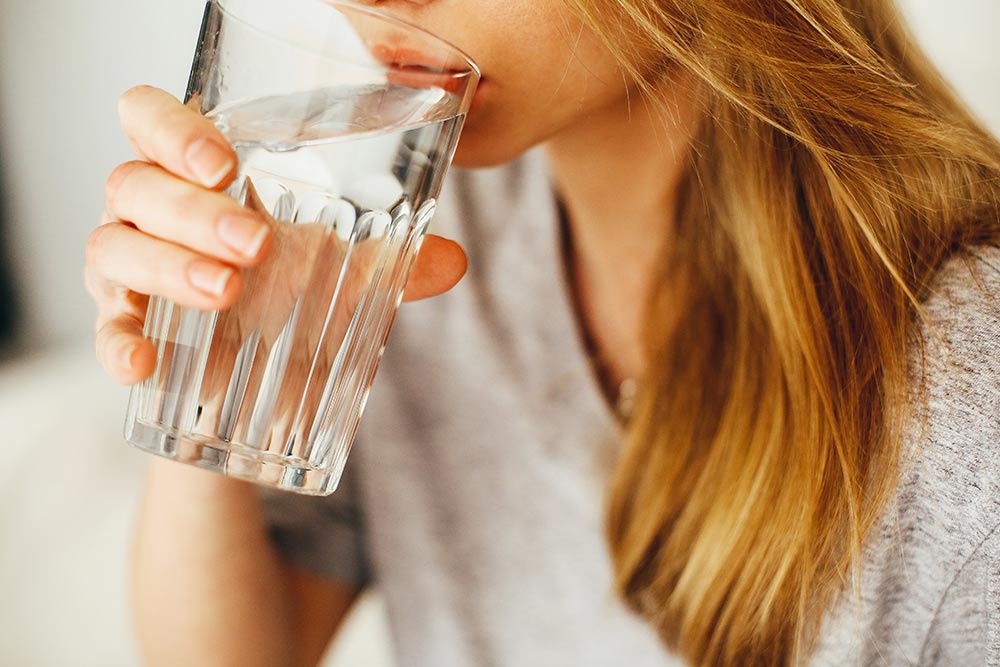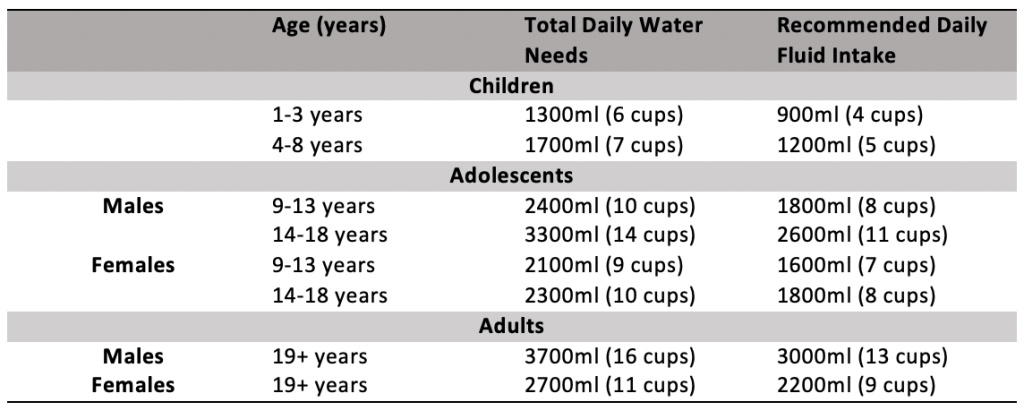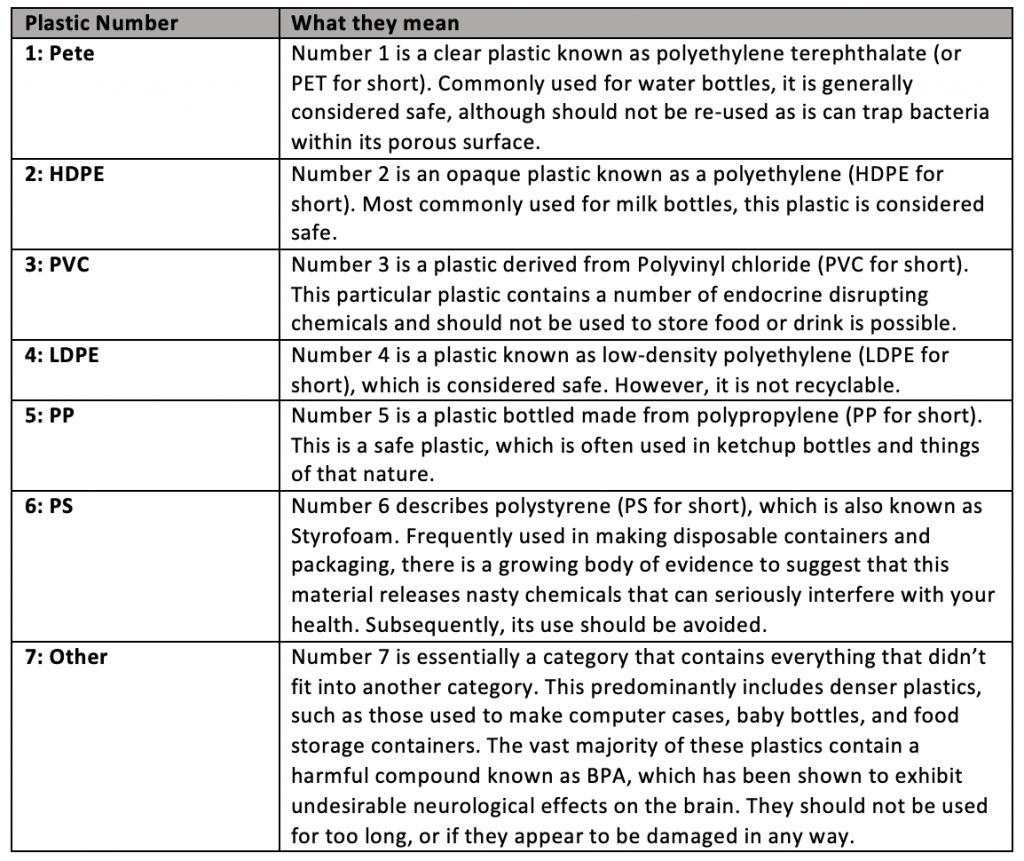Water and Hydration

Hunter Bennett
Given that your body is approximately 60 percent water, it stands to reason that it is essential for health. However, few people realize how incredibly important drinking enough water is. Unfortunately, very few people consume enough of it.
This lack of consumption can lead to a state of chronic dehydration. Chronic dehydration can further result in serious reductions in nearly all aspects of health and function. As a result, making sure you drink enough water is imperative.
However, how much water is needed? And what type of water is best?
What are the current hydration guidelines?
Fortunately, finding out how much water you should be drinking on a daily basis is not a challenging endeavor.
In fact, the Institute of Medicine (IOM) has gone ahead and done just that, creating a thorough set of guidelines that describe the optimal daily water intake, that ensures most healthy individuals will not enter a state of dehydration.
The recommendations are as follows (Riebl, 2013):

Now, I realize that you might be wondering why there is a slight disparity between how much water you need, and your recommended daily intake. This is because a lot of the food we eat on a daily basis actually contains quite a bit of water.
As a result, you only need to drink enough water to supplement the fluid found within the food you eat, and not consume the entire hydration amount.
Should water consumption change with age?
The volume of water you need to drink does actually change with your age up until the 19 years. After 19 years of age which it stays consistent throughout the entirety of your adult life.
This ultimately comes down to body size. As you enter adulthood, your increased size means you are going to need to consume more water to maintain hydration status, and therefore ensure optimal health and function (Picetti, 2017).
Simple really.
Hydration during exercise
I should note that these guidelines are essentially the intake required to maintain health under normal circumstances – however, they don’t really account for the fluid that is likely to be lost during exercise.
Unfortunately, there are not currently any clear guidelines surrounding fluid intake for exercise performance.
So what can we do?
Well, it is well established that as little as a 2 percent reduction in body mass through fluid loss will result in significant declines in exercise performance (Montain, 2008).
With this in mind, aiming to consume somewhere between 150 and 250mls of fluid every 15 minutes during exercise (dependant on your size) appears to offer a fairly acceptable means of maintaining hydration status during exercise, and keeping you performing at your best (Backes, 2016).
Related Article: Effects of Dehydration on Athletic Performance
What is the difference between distilled, spring, and tap water?
Now you have an idea of how much water you should be drinking, it is time to touch on the different types of water that you can drink – which can be quickly broken down into three categories, being spring water, distilled water, and tap water.
Spring Water
Spring water pretty much describes all of the bottled water you find available for sale at the supermarket. This specific type of water comes from an underground source, rather than from the surface like most tap waters.
Most spring water undergoes a mild process of filtration prior to bottling, but can still contain some minerals, which is entirely dependent upon the location of the spring from which it was drawn.
Distilled Water
Distilled water is markedly different from most other waters as it undergoes an intense boiling process that strips it of almost all contaminants, vitamins, and minerals. The steam that results from this boiling process is then captured and cooled—which is what essentially results in what we know as distilled water.
Tap Water
Tap water, as we all know, is the stuff that comes out of your tap.
This specific type of water comes from a central source and has been certified by the government as safe for drinking. Local water authorities provide a number of cleansing protocols. The protocols ensure that microorganisms do not contaminate the water as it travels through pipe systems, and into your home.
In some countries, certain chemicals (such as chlorine and fluoride) are actually added to tap water at the treatment plant to help eliminate certain dietary deficiencies that may plague that specific country.
Which is best?
Onto the million dollar question – which of these types of water is best?
 In my mind, it really comes down to a bit of a tie between both tap water and spring water. Many of the minerals found in both of these water sources can actually have a positive effect on your health and help increase hydration status.
In my mind, it really comes down to a bit of a tie between both tap water and spring water. Many of the minerals found in both of these water sources can actually have a positive effect on your health and help increase hydration status.
This indicates a clear advantage over distilled water.
I would typically choose tap water over spring water in first world countries (such as the USA, Australia, Canada, and most of Europe). Their water quality is extremely high, and their systems are very well regulated.
However, it is also necessary to realize that some countries have markedly lower quality tap water than others – in which spring water quickly becomes your best option in this scenario.
What are the best bottled waters?
If you find yourself in a situation where bottled water is your best option, then you might be wondering what are the best-bottled waters?
Well, as with most things, it depends.
For the most part, when it comes to bottled water, you do get what you pay for. With this in mind, cheaper options are less likely to have undergone a thorough filtration process. In other words, their risk of containing certain bacteria and microorganisms will be slightly higher.
Alternatively, those brands that tend to cost a little more do so because they have undergone a more thorough process of filtration. This will make them safer to drink, essentially making them a better option.
My three favorite brands of bottled water are Fiji, Crystal Geyser, and Just Water.
Each of these is great options as they have undergone a thorough process of filtration and have a pH value of around 7.0 – which actually leads us to our next point quite nicely.
What you need to know about water PH levels
In short, pH describes a measure of electrically charged particles within a given substance. In this manner, the pH of a certain compound indicates how acidic or alkaline that compound is.
The pH scale ranges from 0 to 14.
Acidic water has a pH lower than 7, while alkaline water has a pH of 8 or above. Alternatively, what is known as ‘pure water’ has a pH of 7.0 and is considered completely neutral as it has neither acidic nor alkaline qualities?
The U.S. Environmental Protection Agency is responsible for monitoring the quality of public drinking water quality throughout the United States. Taking this into consideration, the agency recommends that drinking water suppliers should keep their water supply at a pH of between 6.5 and 8.5 (EPA, 2019).
The reason for this appears to be twofold.
Firstly, water with either a very low or very high pH can be a sign of chemical or heavy metal pollution. Secondly, drinking water too far from neutral is though to alter your individual pH levels. This can cause some health complications.
What are the symptoms of unbalanced PH levels?
The normal pH of human blood is typically maintained at a strict measure of 7.40. A decrease of more than 0.05 from this can result in a state of acidosis, which has been linked to declines in metabolic health, and even an increased risk of diabetes (Aoi, 2014).
It is important to note that your blood does have its own pH buffers (such as haemoglobin and albumin) which act to help regulate blood pH levels, keeping it as close to that measure of 7.40 as possible.
However, you can certainly make this process easier on your body by trying to make sure the water you drink sits somewhere between 6.5 and 8 on the pH scale.
Signs and symptoms of unbalanced pH levels can include:
- Extreme sleepiness and fatigue
- Confusion and mental lethargy
- Frequent headaches
- Vomiting or diarrhea
- Seizures
As you can see, the physiological implications of having unbalanced pH levels are quite severe. If you have any reason to believe that yours are out of whack, I recommended seeking medical attention immediately (Kellum, 2000).
Related Article: Calculate Your Sweat Rate
Water in plastic vs glass
We have a good understanding of why it is so important to choose a good quality water source for your hydration. Additionally, I wanted to look at the means in which water is served.
Over the last few years we have seen an increase in the number of bottled waters being sold in glass, rather than in plastic.
Why might this be the case you ask?
Well, there is a growing body of evidence demonstrating that certain chemicals found in commercially available plastic products can seep into the liquid they contain, which are then consumed (Yang, 2011).
While in very small amounts these compounds do not have a huge impact on the human body, if they accumulate, they can begin to cause some damage.
Many of these chemicals have what is known as endocrinological effects on the human body. They have the capacity to alter your hormone levels. Through this interaction, these chemicals can wreak havoc with your health.
As you can imagine, glass bottles offer a very simple method of remedying this problem.
It is also worth mentioning that the chemical makeup of different plastic bottles is not always the same. Not all bottles are created equal. This is right where plastic numbers enter the discussion.
What is the plastic number?
You might have noticed that pretty much every plastic bottle you have ever bought would have had a rather distinct triangle symbol on it. If you look closely at that symbol, it will have a number from one to seven smack bang in the middle of it.
But did you know that this number actually identifies what the bottle is made of?
I have put the necessary information around plastic numbers in the table below to better outline what ones you should avoid if possible.
With all of this in mind, plastic numbers 2, 4, and 5 appear to offer the safest options. The chemicals they contain are not known to cause any undesirable health effects. Plastic 3, 6 and 7, should be avoided at all cost. Number 1 can be used once, but should not be reused.
Take Home Message
In conclusion, hydration is hands down one of the most important things that you can do for the health of your body. This is why drinking enough is paramount.
However, there is so much more to hydration than simply drinking more water. You want to make sure that the water you choose to drink is safe, chemical free, and within an appropriate pH range. It should be packaged in good quality material.
Which is why we have gone ahead and outlined everything you need to know in this article. Let us know what you think!
References
Riebl, Shaun K., and Brenda M. Davy. “The hydration equation: update on water balance and cognitive performance.” ACSM’s health & fitness journal 17.6 (2013): 21.
Picetti, Dominic, et al. “Hydration health literacy in the elderly.” Nutrition and healthy aging 4.3 (2017): 227-237.
Montain, Scott J. “Hydration recommendations for sport 2008.” Current sports medicine reports 7.4 (2008): 187-192.
Backes, T. P., and K. Fitzgerald. “Fluid consumption, exercise, and cognitive performance.” Biology of sport 33.3 (2016): 291.
The United States Environmental Protection Agency (EPA). “Drinking Water Regulations and Contaminants” (2019). From: https://www.epa.gov/dwregdev/drinking-water-regulations-and-contaminants
Aoi, Wataru, and Yoshinori Marunaka. “Importance of pH homeostasis in metabolic health and diseases: the crucial role of membrane proton transport.”. BioMed research international2014 (2014).
Kellum, John A. “Determinants of blood pH in health and disease.” Critical Care 4.1 (2000): 6.
Yang, Chun Z., et al. “Most plastic products release estrogenic chemicals: a potential health problem that can be solved.” Environmental Health Perspectives 119.7 (2011): 989-996.
You Might Like:

















